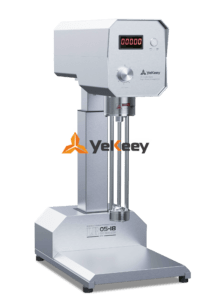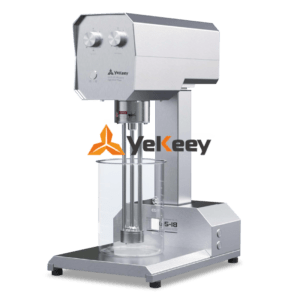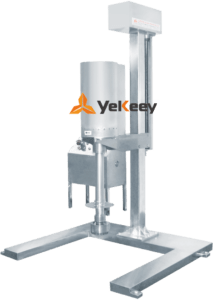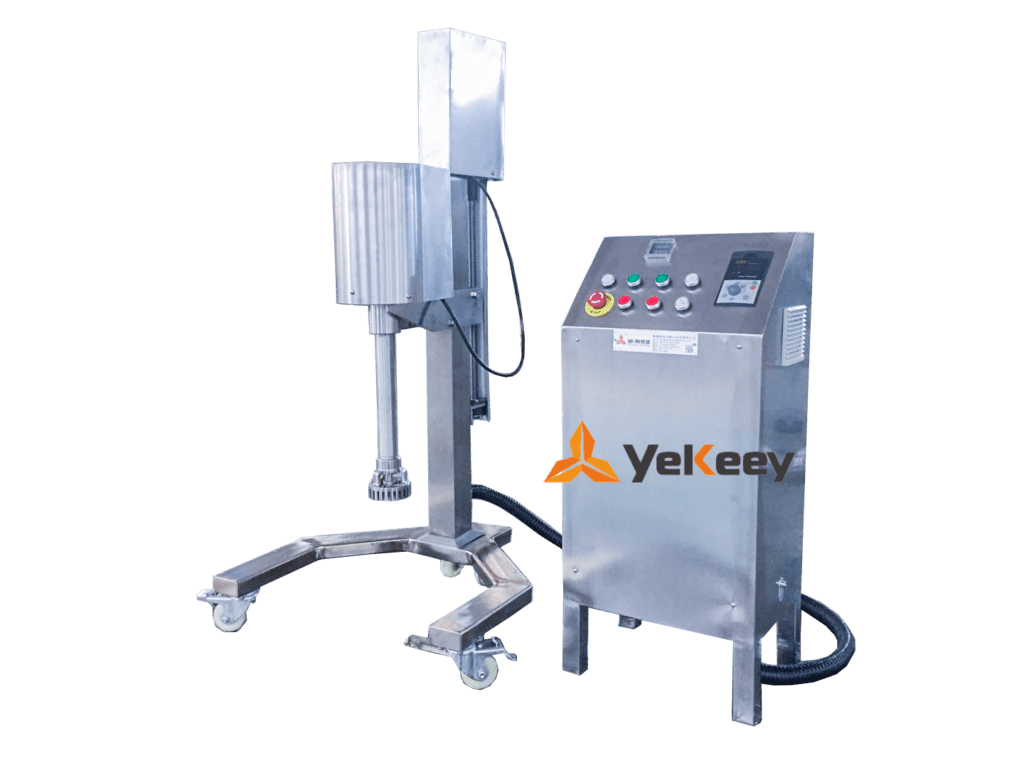-
What is a lab mixer ?
(1) A lab mixer is a device used to stir mixtures in uncured or semi cured chemical reagents in the laboratory.
(2) They can handle substances of different volumes and masses in containers and can mix quickly and evenly.
(3) This type of equipment is usually designed for high hygiene, which can prevent the product from coming into contact with the atmosphere, thereby eliminating the risk of product pollution.
(4) They typically have special stirrer configurations, such as top dual motion reverse stirrers, bottom mounted high shear homogenizers, and bottom portion diffusers, to ensure excellent homogenization and powder impregnation in the liquid phase.
(5) The lab mixer can also be customized to meet different production needs, with functions such as efficient mixing of low viscosity and high viscosity products, improved heat transfer, allowing dispersion and dilution of solids, emulsions, etc.
Laboratory mixers are widely used in chemical raw material manufacturing, chemical equipment manufacturing, and various food and beverage production processes.
-
What is a lab mixer called?
A laboratory mixer is also known as a laboratory stirrer or a laboratory mixer stirrer.
-
What is the principle of lab mixer?
- The working principle of a lab mixer is mainly to generate power through motor drive, which drives the mixing blades to rotate and achieve the mixing of materials.
- The motor converts electrical energy into mechanical energy and transmits power to the mixing blades through a transmission device, causing them to rotate. The rotation of the blade will generate shear force, friction force, and extrusion force on the material, allowing for uniform mixing, dissolution, dispersion, and other operations of the material in the container.
- At the same time, lab mixers can also control the temperature during the mixing process through heating or cooling devices to meet the needs of different experiments.
- A lab mixer usually consists of a mixer, motor, transmission device, heating/cooling device, and other parts. According to different experimental requirements, different types of mixing blades and transmission devices can be selected to achieve the best mixing effect. For example, push type stirring blades are suitable for solid-liquid mixing, dissolution and other operations, while turbine type stirring blades are suitable for gas and liquid dispersion, suspension and other operations.
4. What are the types of lab mixers?
There are several types of laboratory mixers:
(1) Magnetic stirrer: Using the force of a magnetic field to drive the rotation of stirring blades, suitable for stirring low viscosity liquids and solid-liquid mixtures. Magnetic stirrers are available in both heated and unheated types, and the heated type can be used to heat and stir liquids.
(2) Mechanical mixer: composed of a motor, mixing shaft, and sealing device, driven by the motor to rotate the mixing shaft and drive the mixing blade to rotate. Mechanical agitators are suitable for stirring various liquids and solid-liquid mixtures, with large stirring force and high stirring speed.
(3) Manual stirrer: A traditional stirring method that involves stirring liquids or solids by holding a stirring rod. Artificial mixers are suitable for small and simple experiments, but their efficiency is relatively low.
(4) Electric stirrer: The stirring blades are driven by a motor to rotate, and the speed and direction can be adjusted. It is suitable for stirring high viscosity liquids, solids, and solid-liquid mixtures. Electric mixers are usually equipped with various types of mixing blades, which can be selected according to different needs.
(5) Gas stirrer: produces bubbles by introducing gas into the liquid, and uses the rise and rupture of the bubbles to drive the flow of the liquid, thereby achieving stirring of the liquid. The gas stirrer is suitable for stirring gas-liquid mixtures.
(6) In addition to the above types, there are also some laboratory mixers for special purposes, such as mixers for preparing suspension, emulsion, foam liquid and other special liquids, and industrial mixers for industrial production lines.
The selection of laboratory mixers should be based on specific experimental needs and conditions. Different types of mixers are suitable for different experimental conditions and materials, and should be selected according to actual situations.
5. How do I choose a lab mixer?
When choosing a laboratory mixer, the following factors need to be considered:
(1) Clear purpose: Firstly, it is necessary to clarify the purpose of the laboratory mixer, whether it is for mixing, stirring, reaction, or other purposes. Different uses require different types of mixers, so clarifying the purpose is the first step in purchasing.
(2) Determine the materials and parameters for stirring: It is necessary to consider what kind of materials are being stirred, whether they are liquid, solid, or gas, as well as the viscosity, density, and other parameters of the materials. These parameters will determine which mixer is most suitable for selection.
(3) Consider the power and size of the mixer: It is necessary to choose the appropriate power and size based on actual needs to ensure that the mixer can meet experimental requirements.
(4) Consider the material of the mixer: The material of the mixer also needs to be considered, and suitable materials need to be selected based on the characteristics of the materials and experimental requirements.
(5) Comparing the advantages and disadvantages of different brands and models: When choosing, it is necessary to compare the advantages and disadvantages of different brands and models in order to choose the most suitable laboratory mixer for oneself.
(6) Consider after-sales service and maintenance: When choosing, it is also necessary to consider the issues of after-sales service and maintenance to ensure timely support and assistance during use.
(7) Budget considerations: Finally, it is necessary to consider the budget and select the most suitable laboratory mixer based on the actual budget situation.











of course like your website but you have to check the spelling on several of your posts A number of them are rife with spelling issues and I in finding it very troublesome to inform the reality on the other hand I will certainly come back again
Its like you read my mind You appear to know so much about this like you wrote the book in it or something I think that you can do with a few pics to drive the message home a little bit but other than that this is fantastic blog A great read Ill certainly be back